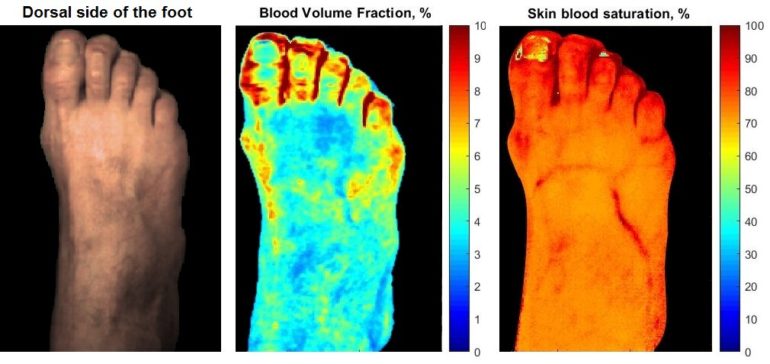Multidisciplinary research team published their research “Skin complications of diabetes mellitus revealed by polarized hyperspectral imaging and machine learning” recently in the IEEE Transactions on Medical Imaging.
In the publication, utilizing emerging photonics-based technology, innovative solutions in machine learning, and definitive physiological characteristics, researchers introduce a diagnostic approach capable of evaluating the skin complications of diabetes mellitus at the very earlier stage.
In this work, we performed a clinical validation of our optical device and a method that we have developed in the frame of the Academy of Finland project. The method allows non-contact detection of possible skin complications of diabetes at an early stage as well as to perform broad population screening, says adjunct professor Alexander Bykov from the University of Oulu who explains the research in more detail in answers below.
What is the key result?
We have developed and performed a clinical test of a compact, portable optical device for non-contact functional characterization of human skin. The device can remotely measure spatial maps of blood oxygen level, blood content and assess the changes in collagen structure of the skin. To achieve this, the hyperspectral imaging and polarization sensing technologies are combined together and accompanied with the advanced algorithms of signal processing based on the artificial neural networks.
Hyperspectral imaging is a technique that unites conventional imaging and spectroscopy. Initially developed as a complex satellite or aircraft-based system, the technology has finally evolved into a compact imaging tool that can be used for medical, industrial, and other relevant applications. Using this technology, both the spatial and spectral information of an object can be acquired. The obtained 3-D image (two spatial and one spectral dimension) consists of about a hundred or more spectral bands for every measured pixel of an object. This precise spectral and spatial information enables detailed analysis of any object or environment. From the other side, optical polarization sensing allows remote assessment of the structural changes inside the object that are unseen by conventional hyperspectral imaging. The neural network algorithms’ implementation allows close to real-time image processing based on the advanced numerical models e.g., the seven-layer skin model we use in our study.
The developed system has been used to reveal early changes in skin blood microcirculation and skin structure of patients with diabetes. The dorsal surface of the patients’ feet has been imaged. It was observed that the diabetic patients had increased skin blood content and, at the same time, the reduced oxygen level in comparison to the control group of healthy volunteers. In addition, the diabetic group has an increased polarization index that is attributed to the changes in skin collagen structure. Thus, the results of the feasibility studies, as well as the actual tests on patients with diabetes and healthy volunteers, clearly show the ability of the developed approach to differentiate diabetic and control groups.
Why is the result important and interesting?
Timely detection of skin disorders caused by diabetes at the early stage is crucial. In people with diabetes, high blood glucose level causes damage to many areas of the body such as eyes, kidneys, legs, and feet. Metabolic alterations at diabetes lead to the obstruction of large arteries but also impairs circulation in small vessels of the lower extremities. These changes cause complications, with diabetic foot ulcers being the major one. It occurs in 2-6% of type 1 and 2 patients with diabetes over their lifetime. If left untreated, the diabetic ulcers may become infected and develop deep tissue necrosis, which may require amputation. Limb loss through major amputation is probably the most severe complication of diabetes, dramatically deteriorating the quality of life and a tremendous burden on the healthcare system. The economic costs of amputation are also huge. Given the aging population, the number of patients at risk will increase in the upcoming decade.
It is known that microvascular lesions are registered already in the first years of diabetes and even at prediabetic conditions long before the clinical symptoms and complications appear. Timely detection of the lesions followed by the appropriate treatment makes it possible to reverse their development at the early preclinical stage, thus saving health, life, and money.
Who are affected by the topic and the results? Where and for whom can the results be of benefit?
Our system is potentially capable to perform monitoring of wound healing and treatment processes, including diabetic foot ulcers, skin burns, or postoperative complications associated with inadequate tissue oxygenation.
The present study was focused on diabetic patients. A common disadvantage of the current methods available to clinicians for the diagnosis of skin diabetic complications is their inability to assess tissue metabolism in a non-invasive and non-contact manner, as well as to determine the location of skin areas most probably exposed to the development of trophic ulcers.
One of the ways to improve the quality of diagnosis is to use hyperspectral and polarization-sensitive optical methods. Their advantages are associated with non-invasiveness, high resolution, and low cost. Using the information obtained by non-invasive optical imaging methods would allow identifying the patients with an increased risk of diabetic foot syndrome and assessing the areas of the lower extremities most prone to the development of ulcerative defects.
Should the results change the current practices (for example in the health care system?)
We do not envisage a dramatic change in the current practice. However, the proposed technique can help the doctors be more objective in performing diagnosis and making decisions. The technique can be in the future adapted for patients’ self-monitoring, which is in line with the strategy of personalized healthcare.
Have you done the clinical tests with real patients?
Yes, the tests in the clinic have been performed for 20 diabetic patients and 20 healthy volunteers in cooperation with our colleagues from the University of Latvia, who helped to organize the tests.
What is the scientific significance of the results?
To the best of our knowledge, the current work is the first one that applies hyperspectrally-resolved polarization index for in vivo study of diabetic skin and Monte Carlo-trained artificial neural networks for processing the hyperspectral measurement data. The proposed diagnostic parameters could serve as biomarkers of diabetic complications. They can also be used to evaluate therapeutic procedures aimed at preventing or reversing diabetic complications. Our results can facilitate the development of biomedical applications of hyperspectral imaging and give a new direction in the studies of age-related diseases.
Is there a need for the further studies?
It would be of interest to perform the tests of the developed system and data processing approach for other relevant clinical applications mentioned above. There is also a huge potential of combining fluorescence sensing and hyperspectral imaging for metabolic skin imaging that we are planning in the future.
Black people with type 1 diabetes, COVID-19 are four times more likely to be hospitalized for diabetic ketoacidosis
More information:
Viktor Dremin et al. Skin complications of diabetes mellitus revealed by polarized hyperspectral imaging and machine learning, IEEE Transactions on Medical Imaging (2021). DOI: 10.1109/TMI.2021.3049591
Provided by
University of Oulu
Citation:
New method reveals the skin complications of diabetes (2021, February 22)
retrieved 22 February 2021
from https://medicalxpress.com/news/2021-02-method-reveals-skin-complications-diabetes.html
This document is subject to copyright. Apart from any fair dealing for the purpose of private study or research, no
part may be reproduced without the written permission. The content is provided for information purposes only.



